How to make kitchari – a rejuvenating and gently detoxifying Ayurvedic dish, balancing to all doshas (constitutions).
Read on to find out how it can support your digestion, reduce inflammation and promote overall vitality, then learn how to make this wonderful traditional recipe.

I love exploring all elements of Ayurvedic healing, particularly the recipes. There are a lot of gems to be gleaned from traditional wisdom – in fact, Ayurveda philosophy dates back as far as 5,000 years or more.
I’ve been on a plant-based diet for close to fifteen years now, and know my way around Indian cuisine fairly well, as it really is a vegetarian’s delight, though my growing interest and love affair with Ayurvedic cooking is more recent.
Today I’m sharing a traditional Ayurvedic dish – kitchari, also known as khichdi.
Kitchari means mixture and is a one-pot meal of split mung beans and rice, traditionally made with a little ghee (clarified butter) and digestive spices. Lovingly referred to as ‘Indian chicken soup’, kitchari is a cleansing and nourishing meal, prescribed therapeutically during a detox or to help a person recover from illness.
Kitchari aids in the clearance of toxins (ama) and strengthens digestive fire (agni). The purifying and tonifying effects of kitchari almost seem to be an oxymoron, being they are opposite ends of a spectrum, but, that's the beauty of this dish!
By the time you add some seasonal vegetables and a dollop of yoghurt, it ticks all nutritional boxes and can therefore safely be consumed as a mono-meal over the course of several days, as in a kitchari cleanse.
The recipe at the end of this post is based on a classic kitchari according to my studies on Ayurvedic cooking and medicine, with some modifications.
I’ve adjusted the spices to suit my predominately Vata constitution, added a dash of coconut cream, and included homemade vegetable broth with a stick of kombu (seaweed) to help contribute extra alkalizing minerals while cooking.
Guys, it’s oh so delicious, a hug in a bowl. You are going to LOVE this. Pure food as medicine.
“Your kitchari recipe is one I turn to time and again, it never fails to nourish when I’m feeling psychically or mentally exhausted. Thank you – on the stove again tonight!”
– Reader feedback
Jump to:

🔥Ayurvedic kitchari benefits
This comforting dish is simple and easy to digest, prescribed therapeutically as part of panchakarma – Ayurveda’s ancient mind-body, cleansing and rejuvenation practice to strengthen the digestive and immune systems, restoring balance and wellbeing.
Kitchari is a balanced meal, providing essential nutrients to support health and healing.
Ideal for the sick, the convalescing, the elderly, the young, and for post-partum and post-operative healing.
Not only that, kitchari is suited to all constitutions, described as vata, pitta and kapha. A slight tweak of the spices is all that’s needed to tailor it to your own body’s needs.
As to how it benefits the body - white basmati rice adds bulk to stools - improving elimination, the mung beans are detoxifying and beneficial to the liver and gallbladder, vegetables provide further nutrients and the spices promote circulation and healthy digestive function.
Finally, kitchari prepared with white basmati rice and split yellow mung beans is naturally gluten free and FODMAP friendly, an ideal choice when a soothing and non-irritating meal is required, while healing a sensitive and inflamed gut (bloating, irregular bowels, a white coating on the tongue and lethargy are all signs of a digestive imbalance).
🌾Kitchari key ingredients
Split yellow mung beans: from whole (green) mung beans that have been split, during which the husks are removed, revealing the lighter, yellow split mung beans [1]. They’re also known as moong dal or mung dal (dal means ‘split’).
The removal of the husks greatly improves digestibility. They are thought to be the only legume not to produce intestinal gas. They are also soaked in advance of making the dish, which further adds to the digestibility.
Legumes in general are a fabulous source of dietary fibre and folic acid. They also include a variety of minerals in good amounts, such as copper, phosphorus, manganese, iron, zinc and potassium. They're a particularly good source of vitamins B1 and B6 [2].
Mung beans are also astringent and bitter in taste, with detoxifying effects. They have a cooling nature and help reduce inflammation in the gastrointestinal tract. In fact, they have even been used traditionally as a remedy for food poisoning.
See below – the whole mung beans are on the left, and the split mung beans on the right. Split yellow mung beans are not the same thing as split peas, chickpeas or lentils.

White basmati rice: like the split mung beans, white basmati rice has been hulled and so is easier on the digestive system. The outer hull of brown rice can irritate a sensitive gastrointestinal tract.
Together, split yellow mung beans and white basmati make a complete protein.
Proteins in the body are made up of combinations of 20 amino acids, nine of which are essential, meaning they must be provided through the diet.
There are 11 non-essential amino acids, which the body can easily make itself, though some of these are conditional, meaning, they become essential under certain circumstances – usually when the body is stressed or sick.
Animal protein sources are complete, whilst plant foods are incomplete.
However, you can combine various plant foods together to create a complete protein, and in fact, this has intuitively been the case for many cultures around the world - for example – beans and rice in Mexico, bean stews with bread in Africa, pasta with beans in Italy, and lentils with rice in India.
Lentils and other pulses are a good source of lysine though lack methionine and the conditional essential amino acid, cysteine. Grains are the perfect complement as they lack lysine though offer methionine and cysteine.

Asafoetida (AKA hing): an incredibly stinky spice. However, its pungent, sulphuric smell luckily subsides upon cooking. Many refer to it as ‘devil’s dung’ because of this.
It is the powdered form of an oleo gum resin obtained from the rhizome and root of a tree native to the Middle East [3].
A staple in Indian cuisine, asafoetida is widely used as a digestive aid.
When paired with typically gas-producing foods such as beans, lentils and cruciferous vegetables, it has an antispasmodic and carminative effect – making them far more tolerable.
According to some Ayurvedic texts, this spice and medicine is classed as a ‘restorer of consciousness’.
It is a common traditional remedy for a variety of ailments, including digestive disorders and excess wind. It is used as a nervine stimulant and sedative, and as an expectorant for respiratory conditions [4].
It is sold in powder form, compounded with rice or wheat flour and gum arabic.
I find that keeping the small jar of asafoetida within a larger airtight container helps prevent the smell from overpowering my pantry - it really is that stinky! You only need just a pinch in cooking, even if you’re making a large one pot meal such as kitchari.
Other common spices used are cumin, coriander, fennel, ginger and turmeric. All of which are calming to the digestive tract.
Ghee: ghee is clarified butter. Butter is cooked until the liquids (water and milk solids) separate from the butterfat, meaning the end product does not contain any casein or lactose – making it available for those with intolerances to both.
The ghee will give you a creamy, buttery taste, though coconut or olive oil will work just fine for vegans.
🥣How to make it
It’s so easy. I’ll show you.
Combine the mung beans with rice in a bowl, cover with water and leave to soak for an hour, then drain and rinse ready for use.
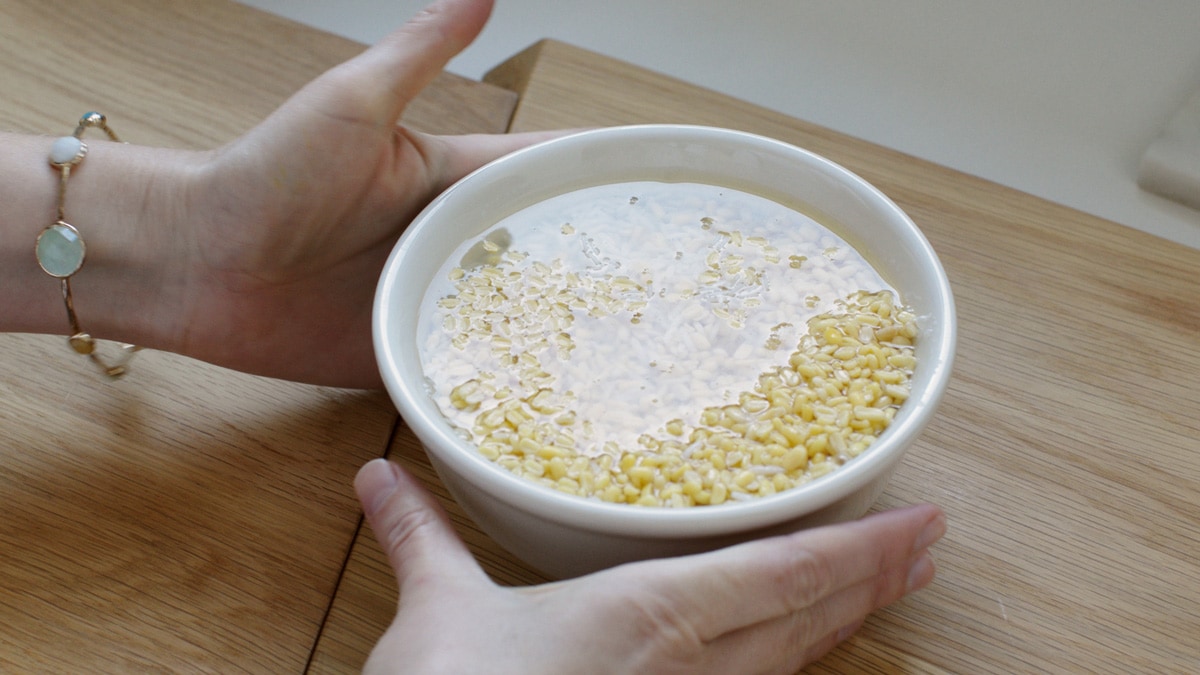
Prep your vegetables – about two cups’ worth. For this recipe I went for butternut, beans and cauli.
Heat ghee or coconut/olive oil in a heavy bottomed pan, over low-medium heat.
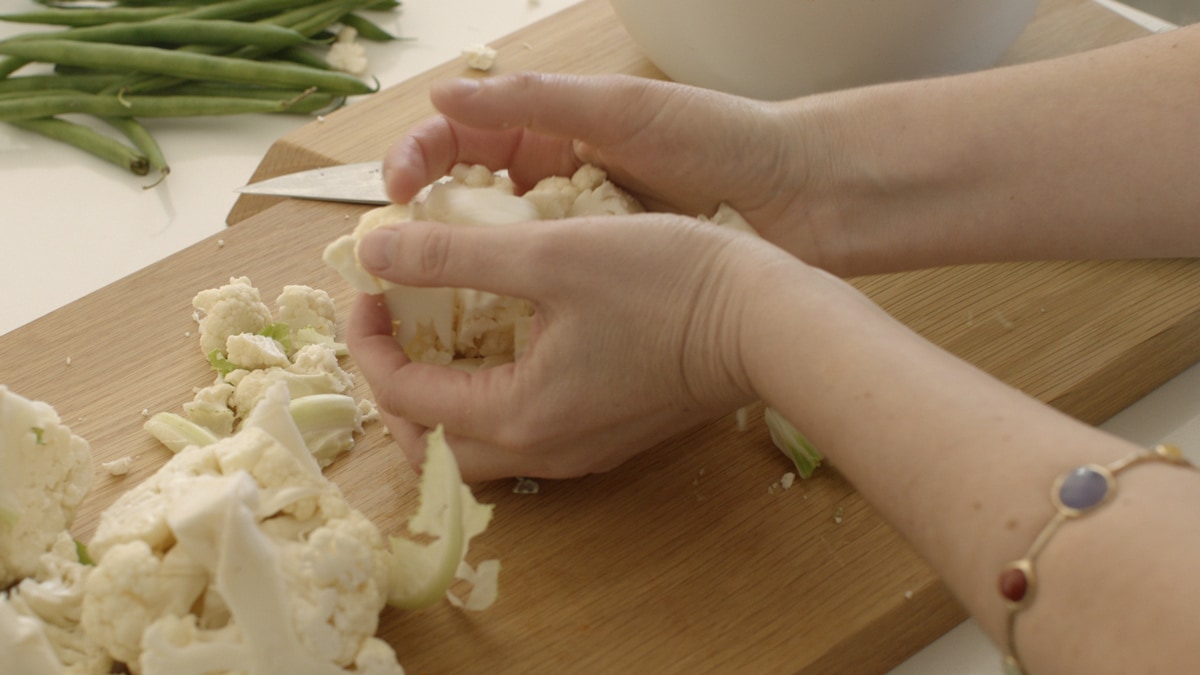
Add your whole spices and let them sizzle until the mustard seeds pop. Stir frequently and be so careful not to burn them or you’ll have to start again!

Now add the fresh ginger and powdered spices and stir to release the aromatics.
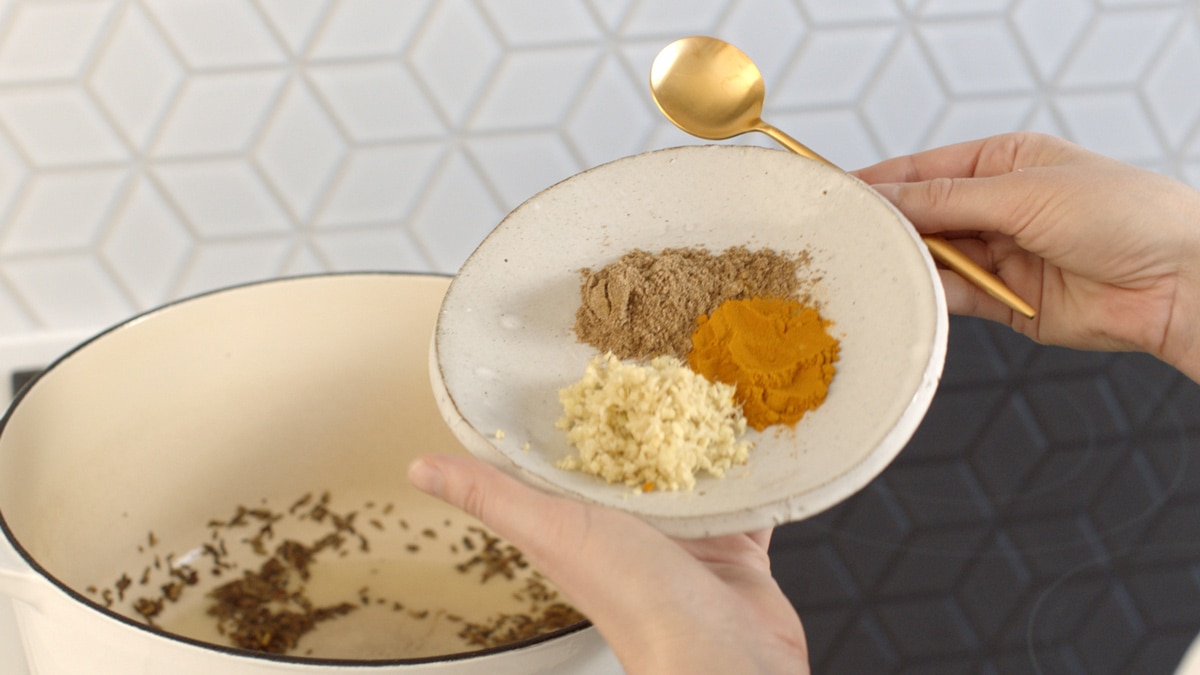
Add your prepared mung beans and rice and stir well.

If using vegetable broth, pour it into the pot, then add a couple of cups of water. A little coconut cream, and a stick of kombu next.
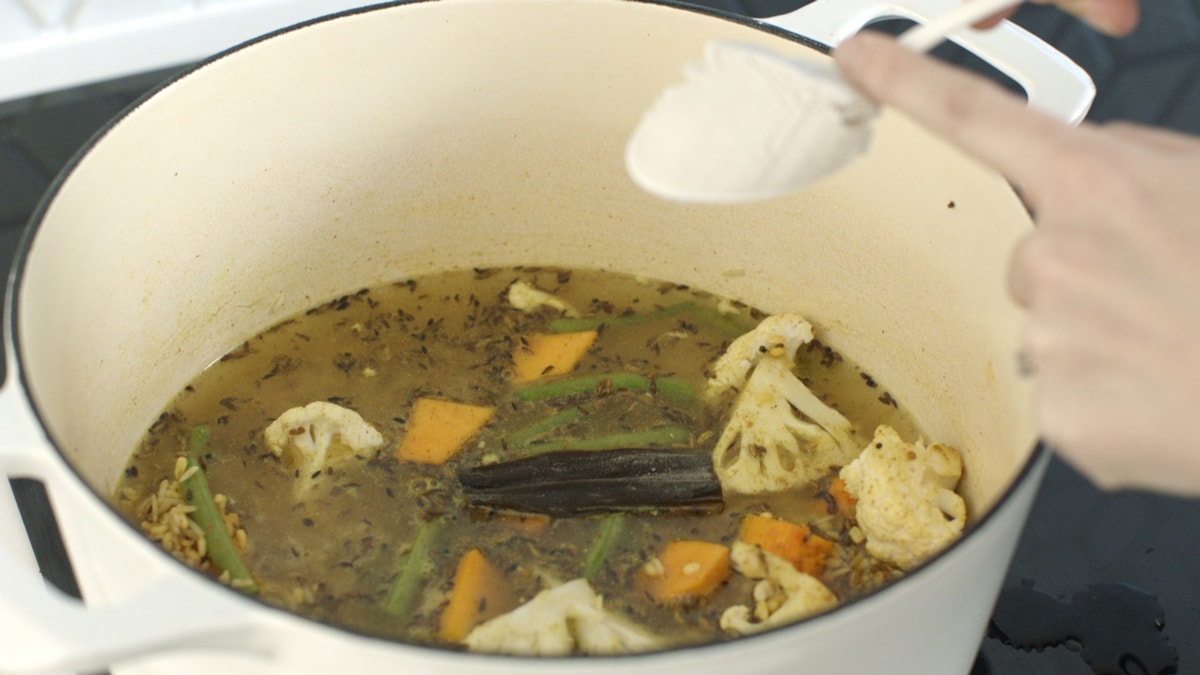
Cover, bring to a boil, and simmer for about 35 minutes, stirring frequently. Once you have a porridge-like consistency, you can remove from the element.
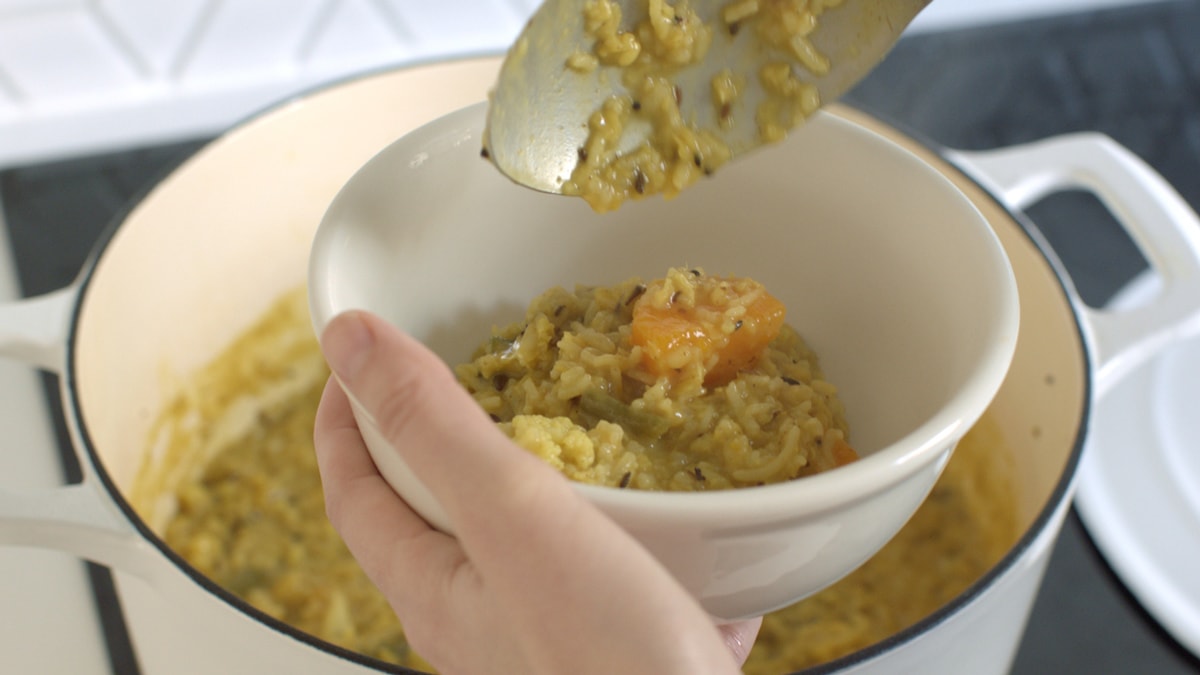
To serve, I highly recommend a sprig or two of fresh cilantro (coriander), a dollop of coconut yoghurt, and a squeeze of fresh lime.
And there you have it – the perfectly balanced meal, and the ultimate Ayurvedic dish. Enjoy!
🥦Tips and substitutions
- You can tailor the spice mix to suit your own needs – however coriander, cumin and fennel are considered tridoshic spices (beneficial for vata, pitta and kapha).
- White basmati rice can be substituted for other whole grains such as quinoa, buckwheat and amaranth.
- Whole mung beans can be used in place of split mung beans, but will require extra soaking and a longer cooking time. Further, the increased fibre may not suit sensitive tummies.
- Avoid using stimulating herbs, vegetables and spices such as garlic, onions, radish and rocket.
- Finally, I went for a 50/50 combination of rice and lentils, but you can adjust this to your taste.
🙋FAQ's
You can keep this dish in the fridge for a couple of days.
Yes, re-heat in a pot over the stove over a low-medium heat, adding a little water to soften and break up the mixture. Stir frequently and after about 10 minutes, it should be warmed through.
🌼More healing recipes
- Ashwagandha Sleep Tonic
- Immune-Boosting Fermented Garlic Honey
- Anti-inflammatory Thai Pumpkin Soup
- Herbal Healing Broth
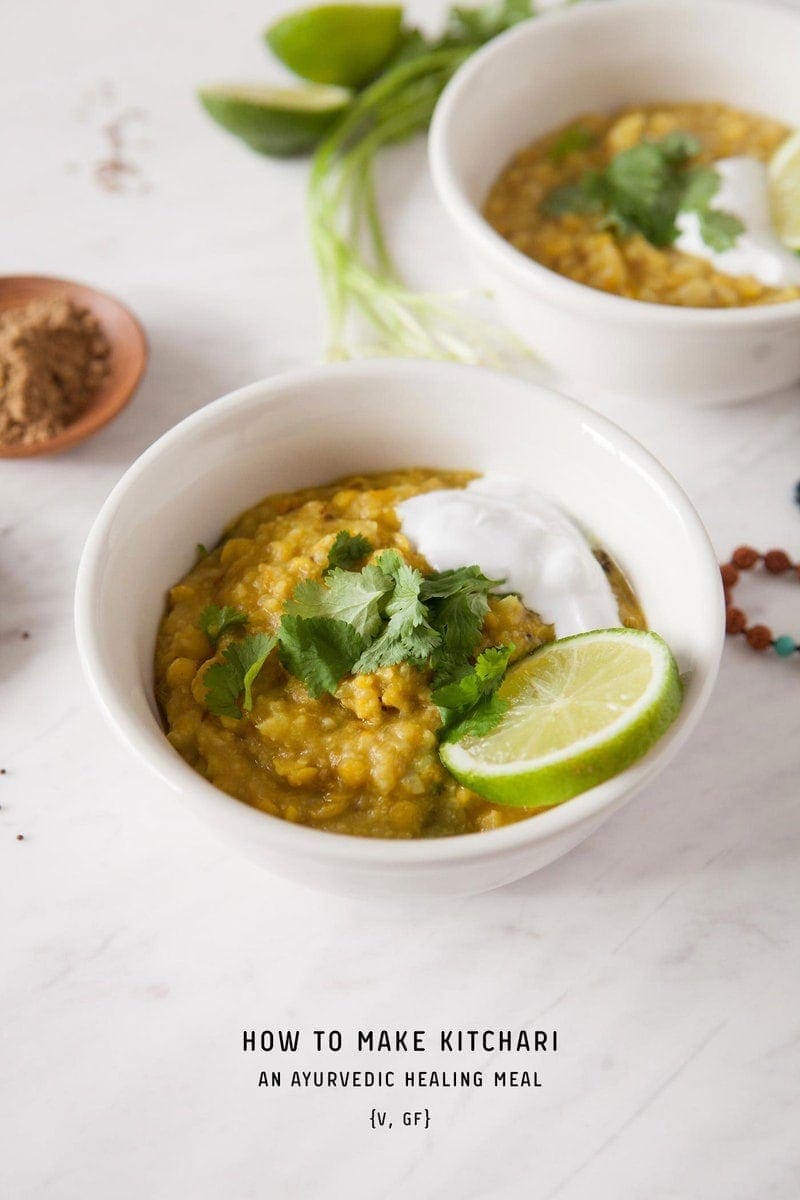
🌿Enjoyed this recipe? Leave a comment below, better yet - share a snap with me on instagram @ascensionkitchen. If you're after personalised health and nutrition advice, contact my clinic, I'd be happy to work with you.
📖Recipe
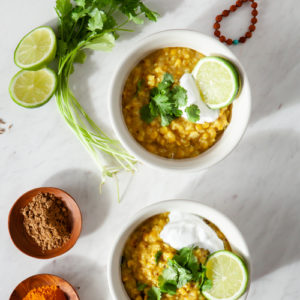
How to make Kitchari – an Ayurvedic healing meal
Equipment
- Large heavy-based saucepan
Ingredients
- ½ cup split yellow mung beans
- ½ cup white basmati rice
- 2 tablespoons ghee, coconut or olive oil
- 1 inch stick of kombu
- 3 cups homemade vegetable stock or water
- 2 cups water
- 2 tablespoons coconut cream
Whole spices:
- 1½ teaspoons cumin seeds
- 1½ teaspoons fennel seeds
- ½ teaspoon fenugreek seeds
- ¼ teaspoon black mustard seeds
Other spices:
- 1 tablespoon ginger root freshly minced
- 1½ teaspoons coriander powder
- ½ teaspoon turmeric powder
- pinch of asafoetida
Vegetables:
- 2 cups any mixed vegetables such as butternut, zucchini, sweet potato, cauliflower
To serve:
- fresh lime
- fresh coriander
- coconut yoghurt
- sea salt to taste
Instructions
- Combine mung beans and rice in a large bowl, cover with water, let soak for one hour, then drain and rinse.
- Prepare vegetables by peeling and chopping them up, set aside.
- Heat coconut oil or ghee over medium heat, in a heavy-bottomed pot. Add cumin, fennel, fenugreek and black mustard seeds and cook for a few minutes to release aromatics, and until the mustard seeds have popped. Add the rest of the spices and stir to combine.
- Add rice and mung beans, stir well and let cook for a moment.
- Add all other ingredients, cover and bring to a boil, then reduce to a low heat. Simmer for about 35 minutes, stirring frequently.
- Check the pot periodically as the rice swells and may stick to the bottom. Add more water if you want a soupier consistency, and simmer longer to get a thicker stew.
- Once cooked, discard the kombu, and serve with fresh coriander chopped and folded through, a drizzle of fresh lime juice, spoon of coconut yoghurt and sea salt to taste if you used water rather than stock.
Video
Notes
- Stick to three vegetables for this recipe - the simpler the combination the easier on the digestive system
- 🌪 Vatas are better for the oil and coconut cream, and ample warming spices
- 🔥 Pittas are better for coconut and coriander, and less of the heating spices (mustard, ginger, excess turmeric)
- 🌎 Kaphas are better for less oil or coconut cream, and more beans
- The stick of kombu is optional, but it does leach valuable minerals into the mixture as it cooks
- If you are cooking on an electric element, stir frequently to prevent it burning.
- Cooking in heavy based pot is ideal as it distributes the heat evenly.
- I have not yet made this in a pressure cooker or instant pot, if you do – could you comment to let me know how it went?
- See here if you’d like to try a kitchari detox
- Nutrition panel is an estimate only and is based on one serve

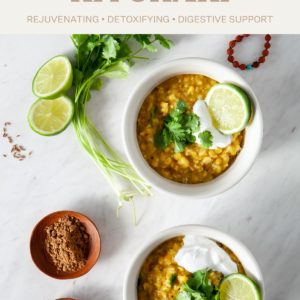
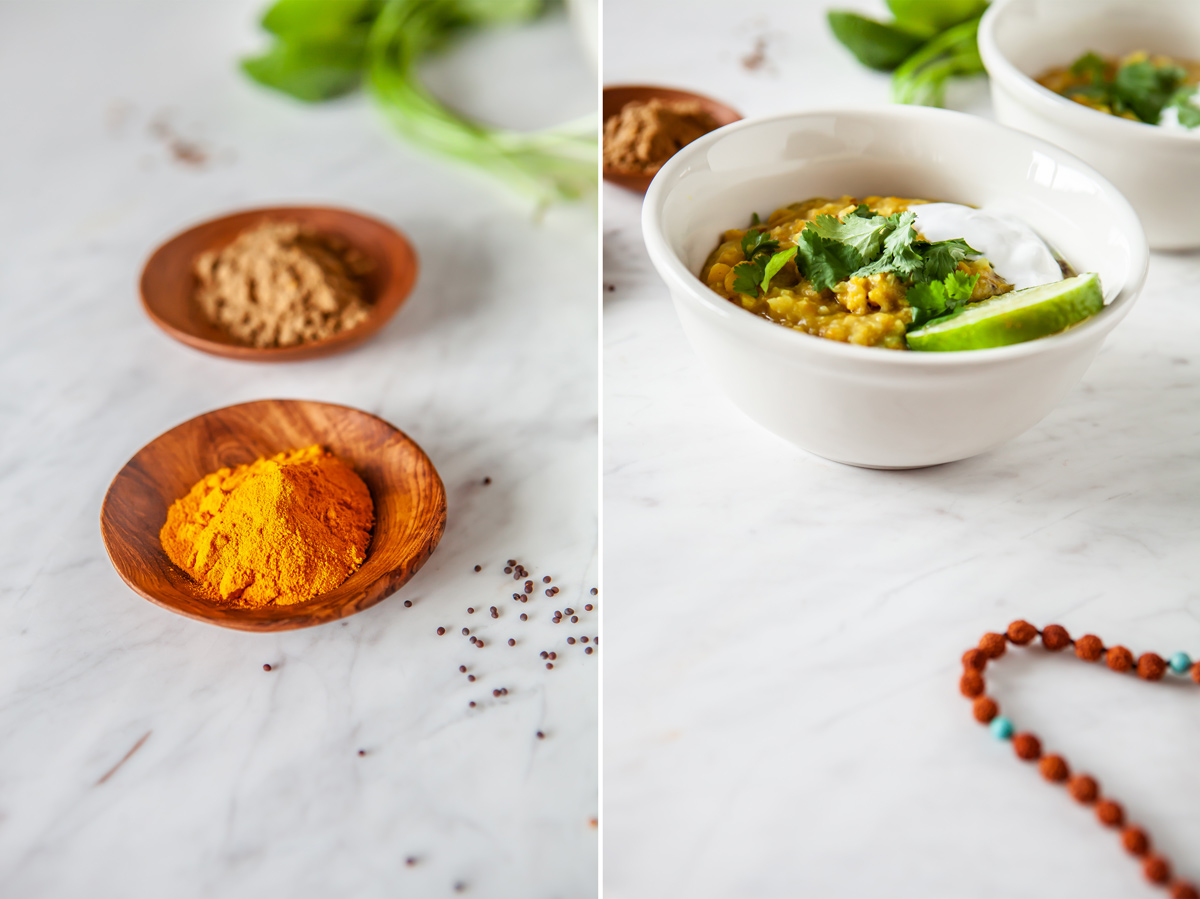

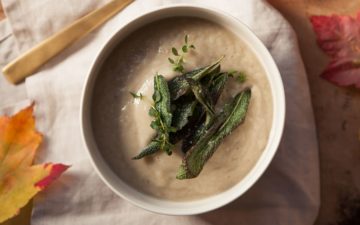

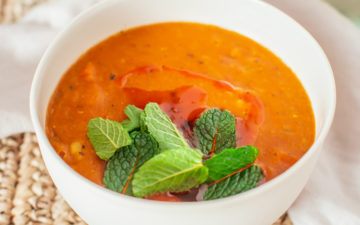
Judith Hoek
I made this in my pressure cooker. I cooked it for 6 mliutes on high pressure. It was creamy and delicious
Avia
Made this for dinner with green beans, pumpkin & baby spinach. It’s like a hug in a bowl, so comforting & restorative. I’ve had a cold which I can’t shake off & this meal made me feel nourished - thank you!
Joanne McPhee
Ever made this in a slow cooker?
Ascension Kitchen
Hi Joanne, no but I'm sure it would work just fine 🙂
Melanie Gulliver
This is so timely! I'm about to go cater an Ayurvedic retreat tomorrow and was just printing off recipes and kitchari was on my list- and then I thought i'll have a 5 minute facebook nose about and this popped up! Thank you.